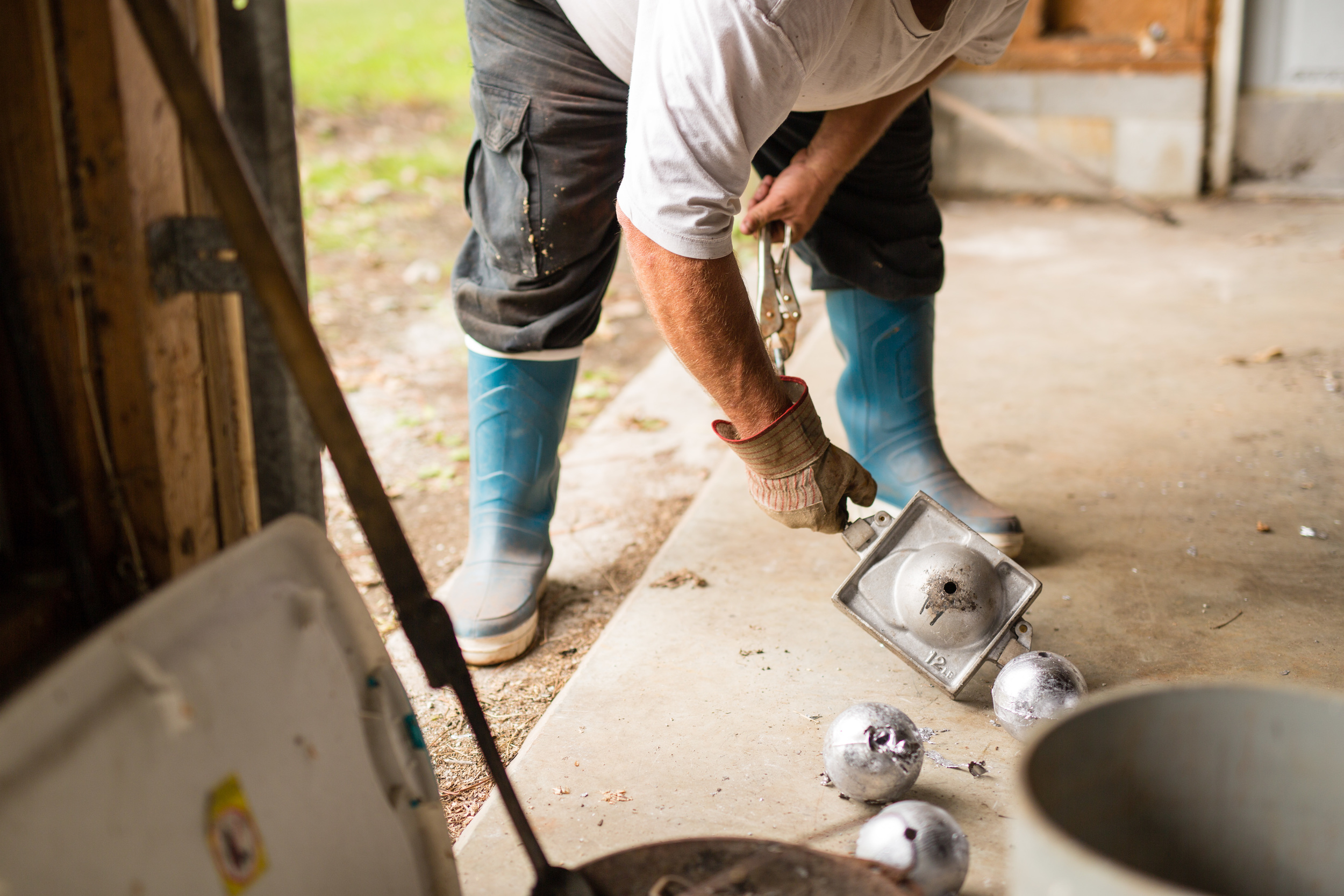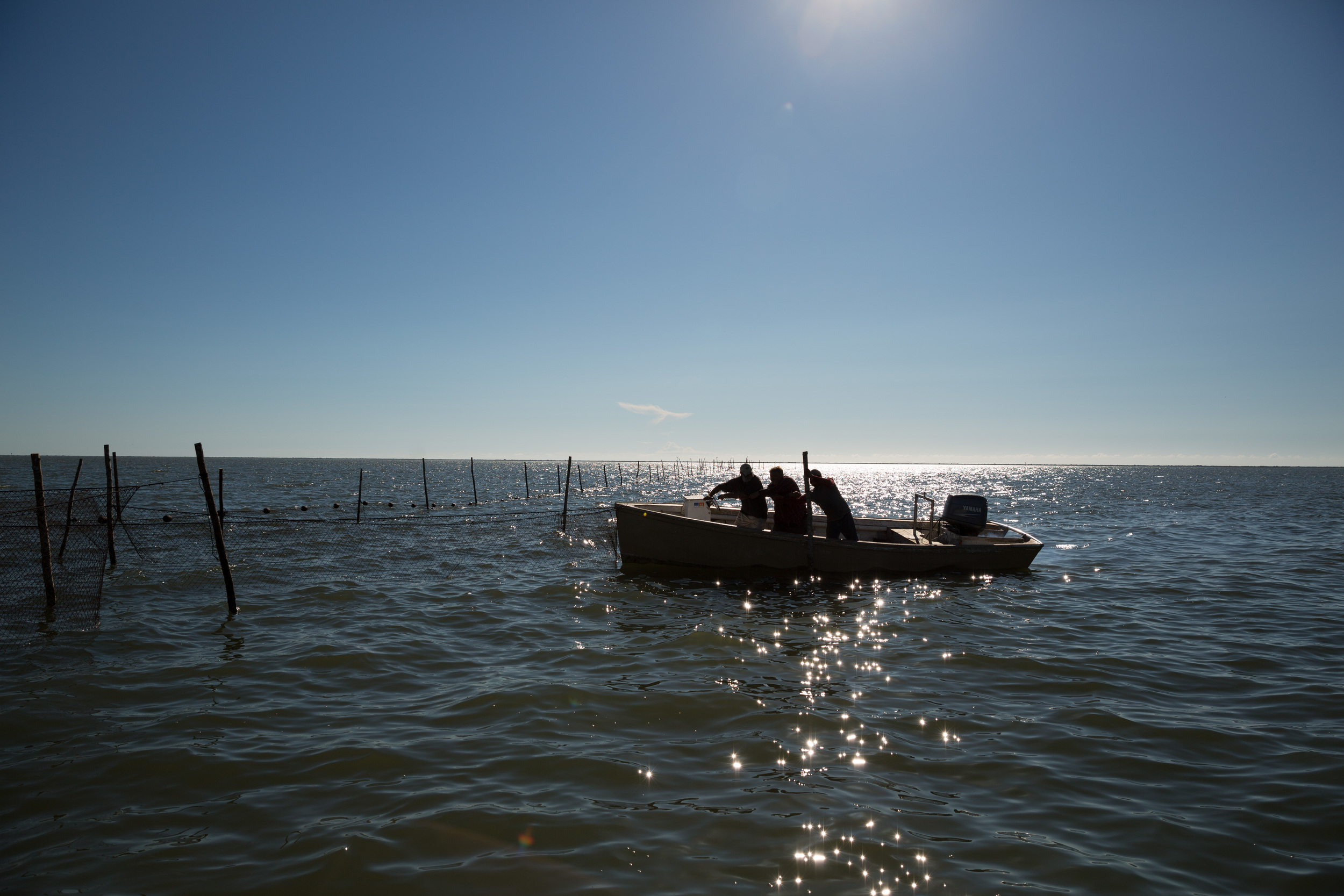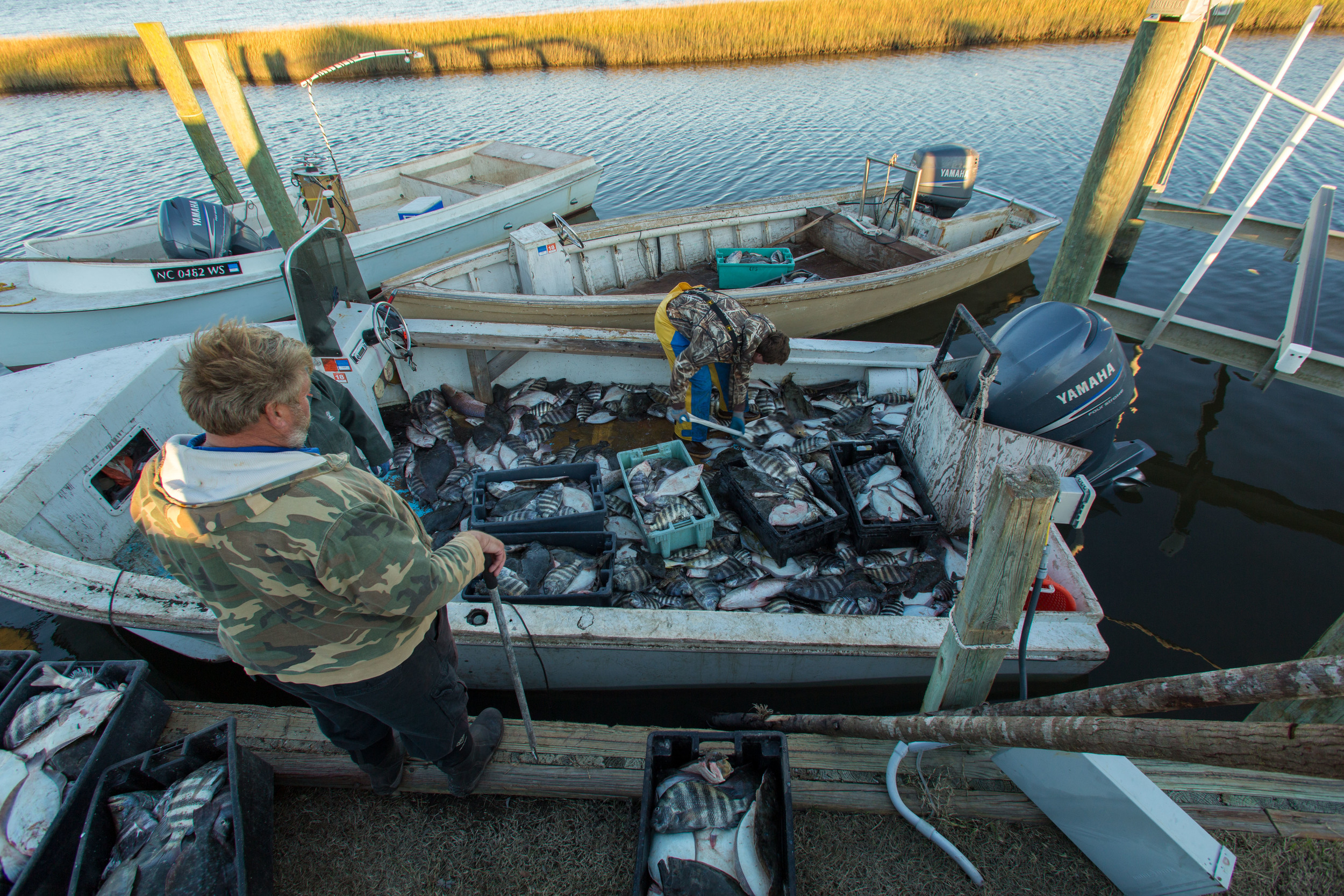A Mess of Feesh
/Story and Photographs by Dan Smith
Eddie Willis cuts an imposing figure. His face and hands are weathered by more than 40 years of working on the waters of the Core Sound. His graying blonde hair stands at odd angles, styled by the constant wind. His body is enormous. He says he’s been big — like his father before him — for as long as he can remember. He answers his cell phone — which always seems to be ringing — the same way he runs his boat: gruffly, with an impatience that implies that just opening the flip phone has already consumed too many precious moments of his day.
Eddie Willis tying a channel net, a skill he learned at age 8.
Like most who are natives of Harkers Island, North Carolina, he’s presumptively cautious of outsiders; ironic sarcasm is his mother tongue, the sound of which, in these parts of Down East, has barely changed since the first English-speakers set foot on the shores in the late 16th Century.
But, just beneath the rough, sun-worn, wind-burnt exterior of a person who’s fished for a living since age 13 is a man driven by family bonds. It was his commitment to family that first set him upon the water, taking his father’s place on a commercial fishing boat in 1979, the day after the elder Willis suffered a debilitating stroke, lest his family be left unable to pay the bills.
Eddie remembers what it felt like to live on little food and barely enough money to keep the lights on and is well aware of the dire straits the commercial fishing industry finds itself in here in North Carolina. Driven to succeed if for no other reason than his wife of five years, Alison, and his three-year-old daughter, Maggie, Eddie has bucked tradition by vertically-integrating the seafood business he took over from his father years ago. Since then, he’s mentored other North Carolina fishermen in the hopes that almost 400 years of a cultural industry lives on long enough, in the face of a globalized seafood market, for his daughter to become the 5th generation of Willis to work the water.
Eddie and Maggie (wearing fishing boots under her princess dress).
Fishing, it seems for Eddie and Alison, is always about the future — the next haul of the net, the next day’s weather, the next season. But pound netting, the primary method they use, is a tradition of the past and one of the oldest fishing techniques used today. English explorer John White’s 1585 series of watercolor paintings along the Outer Banks provides the first recorded depiction of impoundment fishing by the Coree Tribe who fished the waters of the Core Sound for thousands of years before the arrival of the English.
Pound netting is a year-round labor-intensive process that takes place on land and water. Trees from coastal forests are cut and placed in open water and used to anchor a pound set which consists of three nets — a lead line net hung, like a wall, along a hundred-yard-long single-file line of stakes and a basket-like pound net, hung from two dozen stakes arrayed in a box formation, whose entrance tunnel is flanked by two ‘heart’ nets that make it difficult for fish to swim out, once they’ve entered the tunnel. Juvenile fish can swim through the nets, and anything caught inside is free to swim, surface and eat. Strung together, pound nets can stretch for a mile or more across North Carolina’s inshore waters, as they have for centuries.
Last summer, I spent several days pound netting with Eddie and his crew. On a muggy August morning I met Alison on a shoulder of NC-101, near the Parker Boat factory, a few miles from Harkers Island. I parked my car and hopped into her truck that she backed half a mile down a muddy improvised road. We arrived at a small clearing, where a skid loader and trailer sat. Eddie and Alberto, Eddie’s right-hand man and only full-time crew member, were working in the distance. It was only 11am and the men were dripping with sweat, caked in mud up to their calves and surrounded by a cloud of no-see-ems. Eddie was in the process of taking apart a chainsaw to replace its broken chain. The saw’s cover wouldn’t fit — the spring of the blade brake had shifted during the impromptu repair and the clutch sat at a funny angle. After fighting with it for 15 minutes, cussing and fuming about having already lost too many days to rain — he couldn’t lose another to a broken chainsaw — Eddie stuck a screwdriver under the blade brake and pried it out of the housing. “We don’t need it,” he said. “Isn’t that a safety feature?” Alison asked. “Well, I’ll just have to be safe, now, won’t I?” Eddie replied. Alison clucked her tongue and shook her head. Eddie motioned for me to follow, as he set off down an ever-narrowing path, deeper into the woods.
We crossed a small creek passing a pile of empty plastic water bottles, a pile of empty gas cans, and pile after pile of gum trees, each at least 20 feet long, 5 to 6 inches in diameter and straight as an arrow. “We cut 300, yesterday. We’re moving too slow,” Eddie explained as we continued deeper into the woods — the path having disappeared, save for the seemingly endless irregularly-spaced piles of trees. “Last year we cut 1,200 stakes in two days. This year we’ll be lucky to get 900 out of here. We’re having to go too far back, now.” He continued, “Fishermen have been cutting stakes in these woods for hundreds of years — since they’d logged most of the trees of the Island — but there just isn’t as much land. Each year, we move further from the road. We’re almost at the back of this property. Next year, we’ll probably only get 300 out of here and then we’ll have to wait another three or four years before we can come back and cut stakes again.” Eddie abruptly drop-started his chainsaw and set to cutting down a gum tree. Alberto, without a word between them, stepped in to brace the tree with his short, stocky frame, opposite Eddie and in violation of every chainsaw operating manual ever written. The tree fell and Alberto, with a grunt, hefted it over his shoulder, walking towards the nearest pile with a grace and fluidity one rarely expects to witness in the woods, while the sound of a two-stroke engine screamed nearby. The two men worked in rhythm for a dozen more trees, until the pile was judged to be sufficiently large, at which point we walked further into the woods and began anew.
Alberto hefts a newly-cut stake.
Four hours later, as the air became thick with the smell of impending rain, I watched the skid loader weave between thick oaks and thin pines, dragging bundles of logs back to the road, and I imagined 19th century Core Sound fishermen walking these woods, with only handsaws and horses to drag trees, and marveled at the stubborn resilience of the tradition, bolstered by brakeless chainsaws, bobcats and full-size pickups.
A month later, I pulled my car into the driveway at Eddie and Alison’s pastel pink house on Westmouth Bay and was greeted by those same pound stakes, no longer in the sensible context of an old-growth forest, but piled on the lawn, and driveway, and boat ramp, and seawall, and in boats in Eddie’s front yard. These stakes were what was left; Eddie and the team had already set at least half the stakes and his small boat, called ‘the big boat,’ bore witness — the cyan gelcoat on the marine plywood deck looked as though some giant cat had repeatedly clawed it, fore to aft. Piles of foul-smelling pound nets, tied in bags made from old pound nets, lay waiting. All had recently been dipped in “copper” — rendering them an oily umber color; color which gets on everything, from hands to clothes to truck bumpers to cameras and refuses to budge for anything short of dousing them in kerosene. Intended to keep the currents and salt water from abrading the nets in just a few days, I realized this was the source of the red stains that permeated Eddie’s shirts and pants throughout the spring and summer and made Alberto’s hard-worn, sun-chapped hands look more weathered than usual.
The next morning as the dawn broke over Westmouth Bay, at half-past six, Alberto and Bobby, a husky 18-year-old with the wide-eyed look of someone who was no longer a child, but not yet an adult, began dragging the stakes from the pile alongside the boat ramp and placing them into the boat, one at a time. Eddie emerged from the pink house, yelling for them to stop. It would take them all day, at that rate; the boom truck was faster. Boom trucks, used to transport pound nets and poles, are a staple of life for fishermen Down East. Anthropologist Barbara Garrity-Blake once explained in the book Fish House Opera, “boom trucks are as natural to Carteret County fishing villages as skiffs in the yard, nets webbed between trees and stacks of crab pots piled beside sheds.”
Eddie showing an incredulous Bobby how to arrange a pound net, for loading into the skiff, as Alberto looks on.
Alberto’s hands covered in copper net dip.
Eddie’s metallic teal boom truck is prettier than most – at least from the front – and for good reason: it was his father’s Suburban, until he became too ill to fish. At that point, Eddie cut the roof off the cargo bed, tore out the interior, added a hydraulic winch and bolted-in the enormous twin-strut boom, which was donated from the previous truck. A cowlick of sheet metal atop the cab bears witness to the ‘we didn’t even use the back of the napkin’ engineering ingenuity, trimmed back so that the winch cable could reach the block and tackle without interference from the roof. It’s both utilitarian and sentimental, all at once; Maggie loves riding in it, because she can’t be banished to the back seat – there isn’t one.
Eddie proved right — the process of loading three bundles (about 75 stakes) went much faster with the boom truck, despite a lack of brakes, a finicky winch and a transmission that tends to want to slip out of gear. The four of us clambered into the boat— much lower in the water with her hull completely filled with dozens of 20-foot-long logs, held together by seemingly small diameter ropes and headed to set the stakes.
The pink house on Westmouth Bay and the boom truck.
As we rounded the north side of Brown’s island, at about 8am, we slowed near what looked like pilings from dozens of old, abandoned duck blinds but, as we drew closer, I saw that these were trees, planted into the mud — pound stakes. The line of stakes stretched a few hundred yards towards the island, ending in a grouping that roughly formed a box. Bobby took the helm, Alberto started a gasoline powered pump whose drone would ring in our ears for the rest of the day, and Duke, Eddie’s recently paroled younger cousin, grabbed the nearest stake to hold the boat in place as Eddie stuck a long aluminum pole, with the pump’s output hose latched to the end, straight down into the mud. Alberto, resembling a pole vaulter, hefted a log from atop the pile over his shoulder, gracefully walked it over towards Eddie and in one smooth motion placed it exactly where the pump jet had been, sinking the stake vertically in place. Eddie raised his right hand and made a subtle motion to Bobby. We glided to the next spot and the dance began, again; Duke holding us in place, Eddie pumping, and Alberto dancing, as the sun crept higher and puffy clouds swelled to the south. The waves began to swell as the wind picked up, and Eddie, after the first bundle was placed, decided to move to another pound.
Preparing the Big boat at dawn for another day of setting pound stakes
These waters are in Eddie’s family, which, by his own account, saw the value in fishing here, when most others did not. “A few years ago, we had a blow that changed the bottom and we had to shift this entire pound 50 yards north… boy, we were in some fish, then.” We came to a line of stakes that seemed to stretch to the horizon. “My Daddy called this ‘the Great Wall.’ It’s my favorite spot. She’s placed just right so that no one can put a pound, legally, to the north,” said Eddie as he explained state law requires a minimum of 1,000 yards between pound net claims. They began offloading a bundle of stakes into a skiff that had been tied to one of the Great Wall’s existing stakes. As the wind picked up and rain swept along the Sound, Eddie moved methodically toward the Core Banks, placing stake after stake. Maintaining a precise mental map of the pound, and which of its thousands of stakes were rotten, broken or missing, he stopped only to pull old barnacle covered stakes that were loose or in danger of breaking. The stakes would be hauled back to shore and tossed in the marsh to rot. Burning them, Eddie recounted, had led to unwanted visits from the Harkers Island fire department.
After two more boatloads of stakes were set, around 4pm, we returned to the pink house along the creek, and Eddie, grinning ear to ear, at the last moment victoriously turned from the high speed channel, cut the throttle and dramatically slowed the boat as it turned broadside into its own wake. Anxious to set the first pound nets upon the stakes — nets specifically designed to capture sea turtles for tagging and study — Eddie and his crew set to arranging the pound nets, placing them next to the boat, for the next day.
Bobby, Alberto and Eddie, heading out to set stakes
Eddie and Alison (Duke in the center) survey the ‘Great Wall’ after Hurricane Joaquin brought heavy rains to the Outer Banks
Hanging the lead line net the following morning, Eddie surprised me by leaping out of the boat, into chest deep water with a clenched mouthful of thick black industrial zip ties. Duke, standing on the boat’s bow cigarette in his left hand, used his right hand to slip a ringed float over each of the lead line net’s stakes; Eddie followed behind, strapping the floating ring to the net, allowing the net to rise and fall with the tide. After tying off a 300-foot lead line net, Eddie climbed back aboard, exhausted and lifted his flannel shirt, shrugging off a topography of jellyfish stings across his chest. “I’ve had much worse,” he said. Eddie, Alberto and Duke clambered into a smaller pound net skiff while I remained in ‘the big boat’, now moored in place of her smaller coworker. The skiff moved in and out of the box of stakes, weaving the net like an arachnid, Eddie barking commands to Duke and Alberto, until they took hold of the last line and pulled it to raise the tunnel, opening the net to fish. “Gentlemen, that squared-up, beautifully. Thank you,” an exhausted Eddie expressed earnest praise. “And look,” pointing into the pound, “We’ve already caught one horny toad,” the Down East term for a Northern Puffer, bycatch for certain, but a catch, nonetheless.
Eddie and Duke excavating the bottom, for a new stake
Duke, in anticipation of placing a ring float on a lead line stake
Once the nets are set in late September, Eddie will return to them every two to three days until the season’s end on December 1. The process of fishing them is just as labor intensive as setting them. A pound net skiff is run, at some speed, toward the net, while a crewman stands on the bow with a long pole of PVC pipe with a notch at the tip to catch and push the top line of the net under the bow of the boat. As the boat glides over, the motor swings up out of the water and the skiff passes into the pound. Eddie and the crew will work their way from the tunnel to the opposite side. The bottom of the net is lifted the way one rolls up a carpet; when the boat is within arm’s length of the far side of the net, the water begins to boil with life. The crew using a single small dip net, passed down through four generations of Willis fishermen (bearing the wear and tear to prove it — worn ergonomic by the hands of time), begin to lift the catch — flounder, sheepshead, black sea bass, red drum and the occasional cobia — into the boat, while everything else — young and ancient sea turtles, stingrays, horseshoe crabs, puffer fish and undersized fish of all sort — is tossed over the side to swim away, back into the waters of the Core Sound.
As we rode out of the bay into the sound, Eddie told me that the places he was fishing were his father’s spots and his grandfather’s, before him. “I’ve literally walked across the better part of this water, from that point to the shore across — I know the bottom, here, better than the back of my own hand.”

































